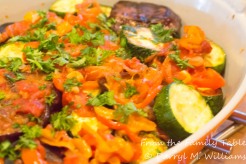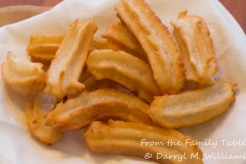Yesterday evening we drove north of Santa Fé to the Estrella del Norte Vineyard located just outside of Nambé Pueblo. The weather was delightfully cool, and the drive was beautiful. The purpose of our trip was to participate in a dinner sponsored by the vineyard.
They have al fresco dinners throughout the summer, but this one was of special interest to us. The guest chef was Lois Ellen Frank. She lives in Santa Fé, but she is internationally known as a chef and cookbook author.
Like most of us, Chef Frank traces a broad heritage, but she is part Kiowa. Possibly because of that, she has had a long-standing interest in the foods of the New World and in the rich and varied cuisines of the Native American peoples. Not only is she a professionally trained photographer and chef, but she also holds a PhD in cultural anthropology with an emphasis in Native American foods and plants. She has travelled extensively throughout North, Central, and South America collecting plants, tracking down traditional recipes, and preparing food with native cooks.
Lois Ellen Frank has been a prodigious cookbook author, and her Foods of the Southwest Indian Nations, (Ten Speed Press, Berkeley, 2002) received the James Beard Kitchenaid Book Award. It is a beautifully illustrated volume that contains many new and original recipes using traditional foods like yucca blossoms, posole, chicos, cactus, and many others. A copy of the book should definitely be on your shelf if you are interested in beautiful photography and/or foods of the Southwest.
The evening turned out to be special. We arrived early so we took a quick tour of the vineyards and grounds. Grapes were ripening on the vine. There were interesting sculptures all around, and a glass of chilled white wine was awaiting us when we arrived in the reception area.
Here’s the menu. Unfortunately none of the recipes are included in the cookbook. That’s ok, because there are similar ingredients and dishes described.
Hors d’oeuvres included chipotlé shrimp with a sweet mango dipping sauce and empanaditas stuffed with either lamb or a vegetarian filling and served with guajillo chile and tomato sauce. These were accompanied by the winery’s vino de manzanas.
Everyone was summoned to dinner at a very long table set under a portal. The first course was caprese made from heirloom tomatoes and fresh basil from the Santa Fé farmers market and a locally-made mozzarella. The accompanying bread was freshly made, and the wine was the vineyard’s Seyval blanc.
Grilled quails were perfectly prepared and served with a red chile honey glaze along with hand-harvested wild rice, yellow corn, mushrooms, chard, roasted beets, and carrots. The wine was the vineyard’s Montepulciano
Dessert was a crisp of local berries served with a choke cherry syrup hand-harvested by the chef and her helpers, topped with whipped cream flavored with canela (Mexico’s “cinnamon”) This beautiful and delicious dessert was complemented by the vineyard’s Luna Rosa Especial port-style dessert wine.
It turned out to be a great evening in a lovely setting with delicious food and lively conversation. I am absolutely certain that Native Americans from earlier times never dined as wonderfully. We will definitely do this again.


















































